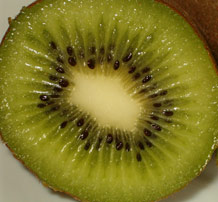
Kiwifruit
International research team unravels origin of devastating kiwifruit disease
An international research team including an Exeter scientist has used the latest DNA sequencing technology to trace a devastating pathogen back to its likely origin of China.
The study, by Virginia Tech (US), University of Tuscia (Italy), University of Exeter (UK), University of Toronto (Canada), Federal University of Mato Grosso do Sul (Brazil) is published today (9 May 2012) in the journal PLoS ONE.
Since 2008, Pseudomonas syringae pv. actinidiae (Psa) has been threatening the world’s kiwifruit industry and destroying orchards in Europe, South America, and New Zealand. In the four years since it was first reported in Italy, the ‘kiwifruit canker’ disease caused by Psa has resulted in hundreds of millions of dollars in economic losses. A similar disease broke out in the 1980s in China and Japan, but nobody knew if it was the same pathogen that is currently wreaking havoc throughout the rest of the kiwifruit world — until now.
Professor Boris Vinatzer of Virginia Tech’s College of Agriculture and Life Sciences said: “It was detective work. By sequencing the DNA, we were able to link all the bacteria back to a strain in China and determine where it probably all began.”
Dr David Studholme of Biosciences at the University of Exeter said: “This work exemplifies the value of cutting-edge DNA sequence analysis technologies when we're faced with new diseases of crops. It can tell us a great deal about the bacteria responsible. We have also been applying these same methods to tackle bacterial diseases of tomatoes and bananas and, closer to home, bleeding canker on horse chestnut trees.”
The UK imports thousands of tonnes of kiwifruit every year. It is difficult to predict the long-term impact of the disease, but if it continues to spread to throughout the world it will probably mean reduced supply and higher prices for this popular fruit.
The team sequenced the entire DNA of Psa bacteria from kiwifruit vines in China, Italy, and Portugal. They also analysed some bacteria from New Zealand, where kiwifruits are an almost $1 billion industry. Psa causes a red or white bacterial slime to ooze out of the plant’s stems and branches. In the worst case, the entire plant wilts and dies.
To find the source of the disease, the researchers examined how the bacteria may have evolved from the same ancestor by comparing the DNA from the different bacteria to each other. They found that the bacteria from China, Europe, and New Zealand were almost identical; but one small difference in one region of the DNA linked the New Zealand outbreak to the Chinese bacteria. The researchers think that the most likely scenario is that the bacterium was imported from China into Italy and from China into New Zealand independently.
“The first step in stopping the spread of aggressive bacteria like Psa is knowing where they come from and how they have spread,” said Professor Giorgio Balestra of the University of Tuscia. “Now that we have sequenced the DNA and found its likely origin, we can start to figure out ways to stop it and similar bacteria from doing so much damage in the future.”
Besides having direct practical applications, the study will also lead to new insights into the adaptation of bacterial plant pathogens to crops.
Date: 9 May 2012

